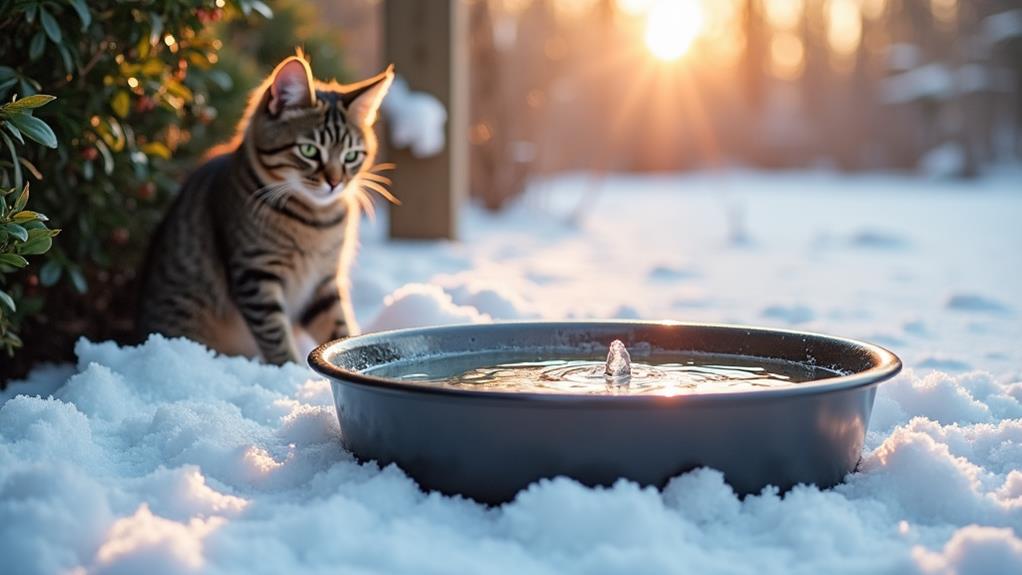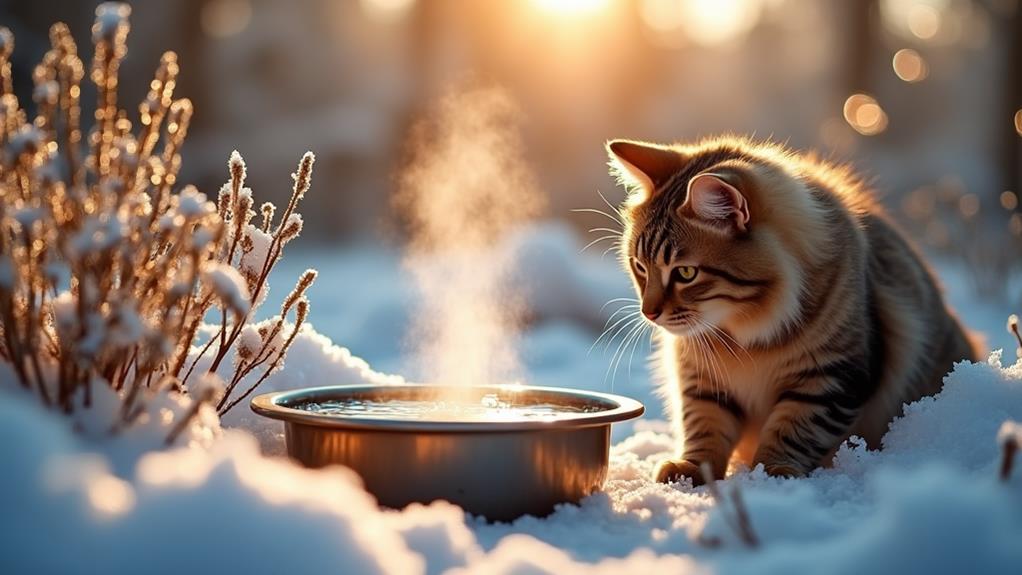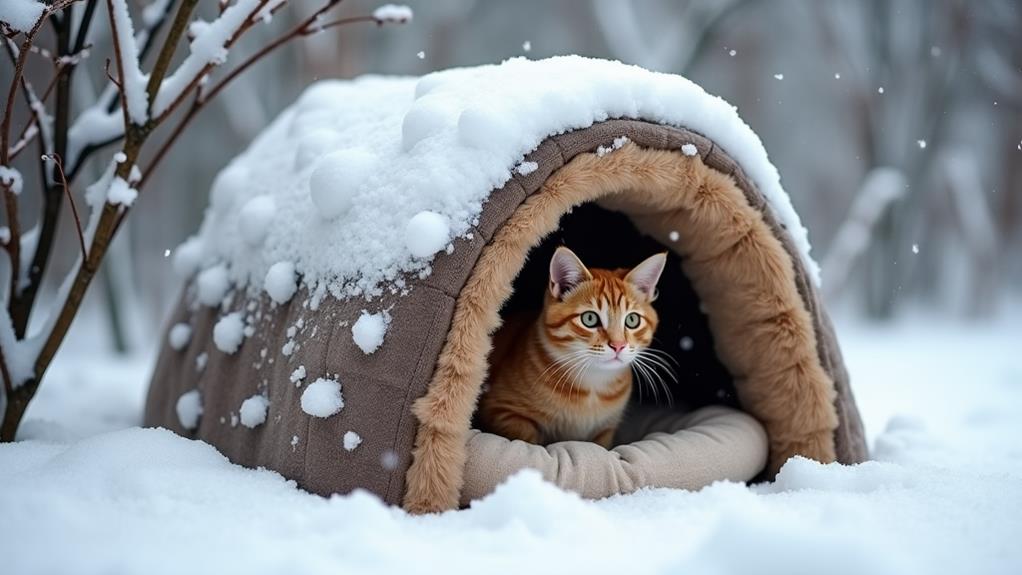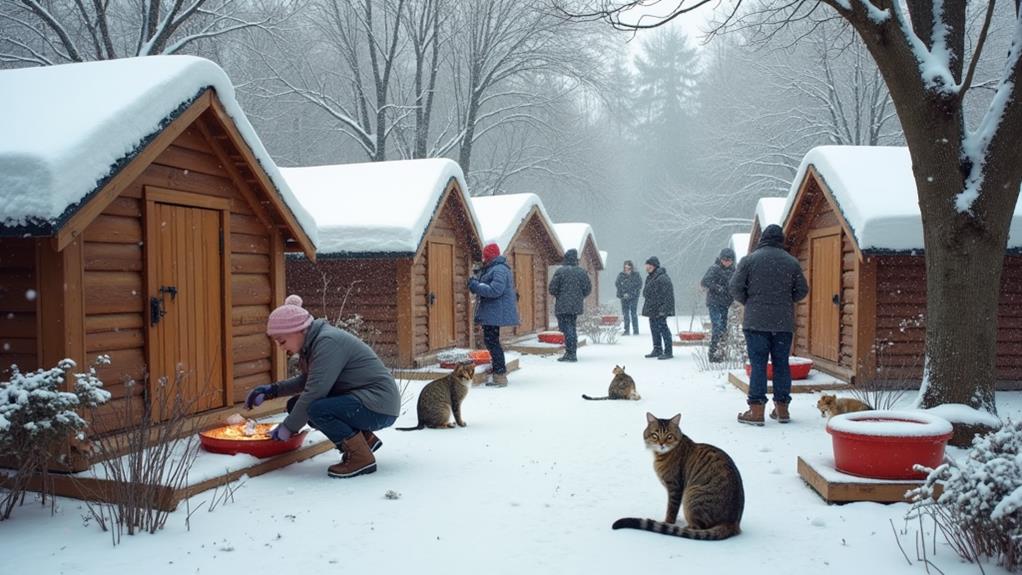How to Keep Feral Cat Water From Freezing in Cold Weather

To keep feral cat water from freezing in cold weather, start by using thick plastic or ceramic bowls for better insulation. Place the bowls in sheltered areas and float a rubber ball inside to prevent ice formation. If you can, opt for heated water bowls or wrap heat cables around containers for extra warmth. Consider utilizing styrofoam coolers or layers to insulate the setup further. Always refill bowls at least twice a day and position them in sunny spots when possible. For a more thorough approach to maintaining liquid water in winter conditions, examine supplementary strategies and insights.
Insulated Water Bowl Techniques
Why let your feral cat's water freeze when you can use insulated water bowl techniques to prevent it? Start by choosing thick plastic or ceramic bowls instead of metal ones. These materials naturally retain heat better, reducing the chance of freezing. Positioning your water bowls strategically can make a difference too. Placing them in sheltered areas, like under canopies or near heated surfaces, offers protection from the wind and cold, further helping to keep the water from freezing.
To improve insulation, consider a clever setup using a larger styrofoam container. Cut an access hole and place your water bowl inside. This method traps heat and delays freezing. Furthermore, try the double bowl system. Here, you place a smaller bowl inside a larger one and fill the space between them with insulating materials such as packing peanuts or straw. This setup maintains warmth and keeps the water accessible longer.
For a simple trick, float a small rubber ball in the water bowl. The ball moves with the wind or when a cat approaches, disrupting ice formation and preventing a solid freeze. This guarantees your feral cats have access to unfrozen water.
Heated Water Bowl Options
When battling freezing temperatures, heated water bowl options offer a reliable solution to keep your feral cats' water unfrozen. These bowls are designed to prevent freezing, guaranteeing your feral cats always have access to fresh water. Opt for a heated water bowl with at least a 1-gallon capacity, as this assures there's enough water for the entire day. You'll find these bowls in materials like stainless steel and plastic, each offering durability and ease of cleaning.
One popular choice is the K&H Products Thermal-Bowl, priced at around $24. It's equipped with a chew-resistant cord, making it both safe and effective in maintaining unfrozen water in cold conditions. However, remember, regular maintenance is key. Heated bowls need daily refills due to evaporation, securing your feral cats don't run out of water during winter months.
For added insulation, consider pairing your heated water bowl with Snuggle Safe microwave heat pads. These pads provide warmth for 2-3 hours outdoors, enhancing the bowl's effectiveness. By choosing the right heated water bowl and maintaining it properly, you're taking an essential step in caring for your feral cats during freezing weather.
Using Solar Energy

Have you considered using solar energy to keep your feral cats' water from freezing? Solar-powered solutions, like the Solar Sipper, are excellent for maintaining accessible water bowls for outdoor cats, even in colder weather. This device is specially designed to prevent freezing down to 20°F, utilizing solar energy to maintain the appropriate temperature. It holds one quart of water and includes insulating properties to guarantee water remains unfrozen during warmer periods as well.
Using solar energy can greatly reduce the need for constant monitoring and refilling of water bowls, offering a more sustainable and convenient approach. For peak effectiveness, place these solar-powered devices in direct sunlight, particularly during daylight hours. This guarantees that the solar components work at their best, providing consistent temperatures to keep the water from freezing.
You can find these solar-powered water solutions readily available from numerous online retailers, including Amazon, making it easy to support the welfare of your outdoor cats. By investing in solar energy, you're not only assuring your cats have access to water in cold weather but also embracing an environmentally friendly solution that requires less manual intervention.
Creative Water Heating Ideas
Curious about creative ways to keep your feral cats' water from freezing? You can try several cutting-edge methods that make a real difference. Here are some ideas to keep their water bowls heated during chilly nights:
- Snuggle Safe Microwave Heat Pads: Pop these pads in the microwave, and they'll provide warmth for your water bowl for 2-3 hours, delaying freezing outdoors. It's a quick, effective solution for those extra cold evenings.
- Styrofoam Coolers: Place your water bowls inside a styrofoam cooler. This insulation slows down freezing, ensuring your furry friends always have liquid water. It's an affordable and simple trick that works wonders.
- Old Tires with Dark-Colored Rocks: Fill an old tire with dark rocks. During the day, they absorb sunlight and then radiate warmth at night, keeping your water bucket from freezing. It's an eco-friendly, resourceful approach to heat.
- Heating Cables: Wrap heating cables around your outdoor water containers. They offer consistent warmth, ensuring your water doesn't freeze, even when temperatures plummet.
These creative solutions not only keep your feral cats hydrated but also show them you care, even in the coldest weather.
Essential Shelter Tips

While keeping water from freezing is important, providing adequate shelter is likewise vital for the well-being of feral cats during winter. Insulated shelters help cats retain body heat, fundamental for surviving cold weather. You can create effective shelters by using small spaces that trap warmth, making certain they're cozy but not cramped. Repurposing materials like old dog houses or storage bins works well. Just make certain they have proper entrances and are raised off the ground to avoid moisture buildup that could freeze just like a water bowl.
For insulation, opt for materials like straw, pillowcases filled with packing peanuts, or shredded newspaper. These materials are better at retaining warmth compared to blankets or towels, which can absorb moisture and lose their insulating properties. Regularly check these shelters to guarantee they remain dry and warm, as damp conditions can undermine their effectiveness.
Consider engaging your local community or youth groups in shelter-building initiatives. This not only fosters a sense of collaboration but also pools resources to create suitable habitats. By taking these steps, you'll guarantee feral cats have a safe, warm place to stay, complementing your efforts to keep their water bowl from freezing.
Strategic Water Placement
Why is strategic water placement important for feral cats? It guarantees that feral cats have consistent access to water even in freezing conditions. By positioning water bowls near insulated shelters, you reduce the distance cats need to travel. This not only conserves their energy but also minimizes the risk of water freezing during their expedition.
Consider these strategies to help keep water from freezing:
- Create a Canopy: Install a cover between water sources and shelters. This blocks cold winds and precipitation, which can quickly freeze water.
- Use Thick Plastic Containers: Opt for thick plastic over metal bowls. Plastic provides better insulation, slowing down the freezing process.
- Place Bowls in Sunny Spots: During the day, place water bowls in areas that receive sunlight. The natural warmth helps prevent freezing and maintains a liquid state longer.
- Regularly Check and Refill: Regularly monitor and top off water sources. Fresh, warmer water takes longer to freeze than stagnant cold water.
Strategic water placement is significant for the survival of feral cats in cold weather. By implementing these tips, you can guarantee they have reliable access to water, essential for their well-being.
Community Support and Resources

After setting up strategic water placement, look to community support and resources for further assistance in keeping feral cats hydrated during winter. Collaborating with local community groups, like youth organizations or animal welfare volunteers, can be a game-changer. By joining forces, you can build insulated shelters and water containers, ensuring feral cats have a fighting chance against freezing temperatures. These efforts not only help the animals but also strengthen community bonds.
Reach out to local building supply stores; they often have resources or scrap materials that can be repurposed for creating insulated shelters. This not only reduces costs but also promotes environmental sustainability by recycling materials. Organizing shelter-building parties can be a fun and engaging way to raise awareness about feral cat care in your community.
Additionally, consider participating in Trap-Neuter-Return (TNR) programs. With community backing, these initiatives provide crucial medical care, plus shelter and food resources for the cats. Donations to local animal welfare organizations can also enhance resources, helping to maintain hydration and shelter for feral colonies. By tapping into community support, you're not just addressing immediate needs but also creating a lasting impact on feral cat welfare.
Regular Maintenance Practices
To keep feral cats hydrated during winter, regular maintenance of their water sources is essential. You need to check and refill water bowls at least twice daily. This simple act guarantees that the water is always available and greatly reduces the risk of freezing, especially during harsh cold spells. Opt for thick plastic or ceramic bowls instead of metal ones, as they retain warmth better and help prevent the water from freezing quickly.
Incorporate insulation techniques to further protect these important water sources. Placing bowls inside styrofoam coolers or using insulated covers can make a considerable difference. Keeping a consistent schedule for monitoring the water levels and temperature allows you to adjust your approach based on daily weather changes, guaranteeing ideal hydration for the cats.
Here's how you can make a difference:
- Refill regularly: Keep the bowls full to prevent freezing.
- Choose wisely: Use non-metallic bowls to retain warmth.
- Insulate effectively: Use covers or coolers to shield from cold.
- Rotate frequently: Swap out containers with warm water during the day.




